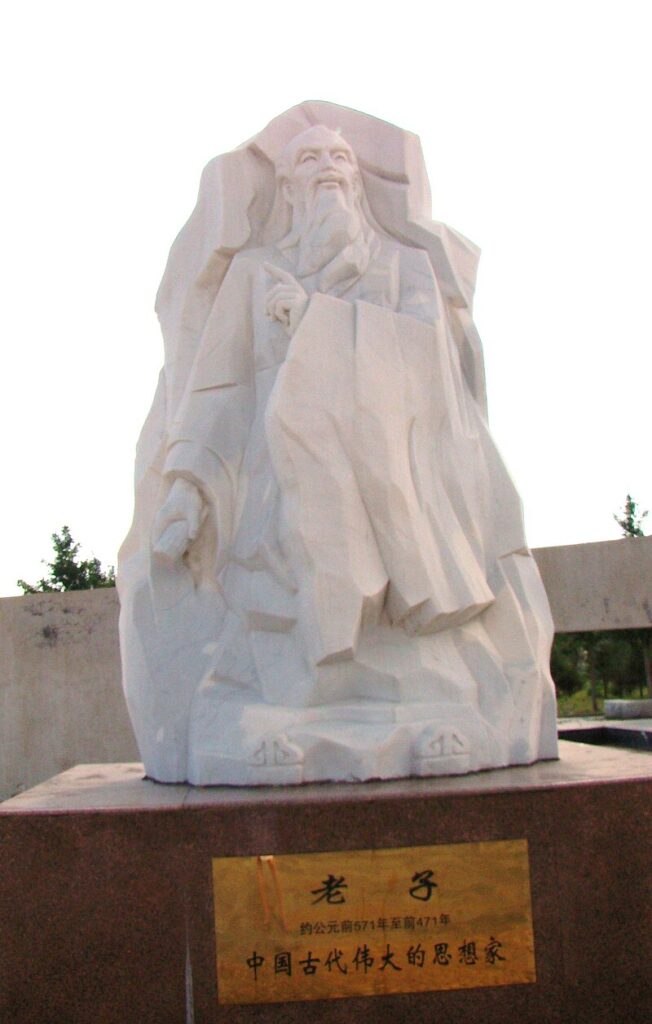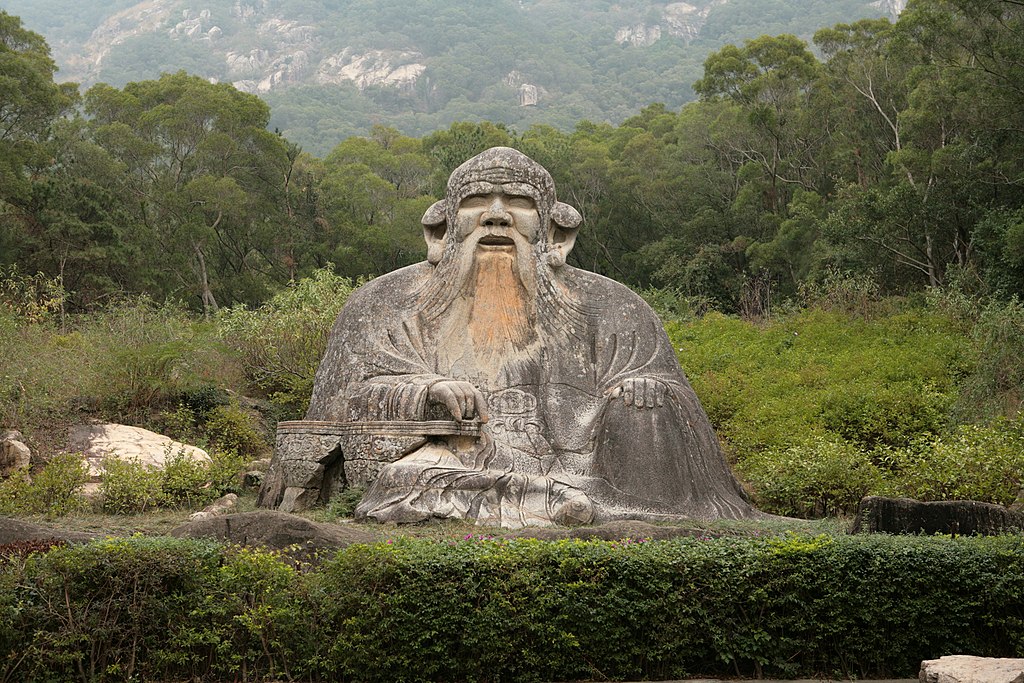
There was something formed out of chaos,
That was born before Heaven and Earth.
Quiet and still! Pure and deep!
It stands on its own and doesn’t change.
It can be regarded as the mother of Heaven and Earth.
I do not yet know its name:
I “style” it “the Way.”
Were I forced to give it a name, I would call it “the Great.”
“Great” means “to depart”;
“To depart” means “to be far away”;
And “to be far away” means “to return.”
The Way is great;
Heaven is great;
Earth is great;
And the king is also great.
In the country there are four greats, and the king occupies one place among them.
Man models himself on the Earth;
The Earth models itself on Heaven;
Heaven models itself on the Way;
And the Way models itself on that which is so on its own.
(Translated by Robert Henricks)
The meaning here is rather straightforward.
Su Ch’e says: “The Tao is not pure or muddy, high or low, past or future, good or bad. Its body is a nebulous whole. In Man it becomes his nature. It doesn’t know it exists, and yet it endures forever. Heaven and Earth are created within it.”
Ho-Shang Kung says: “The Tao is great because there is nothing it does not encompass. Heaven is great because there is nothing it does not cover. Earth is great because there is nothing he does not control. Man should imitate Earth and be peaceful and pliant, plant it and harvest its grains, dig it and find its springs, work without exhaustion and succeed without fuss. As for Earth imitating Heaven, Heaven is still and immutable. It gives without seeking a reward. It nourishes all creatures and takes nothing for itself. As for Heaven imitating the Tao, the Tao is silent and does not speak. It directs breath and essence unseen, and thus all things come to be. As for the Tao imitating itself, the nature of the Tao is to be itself. It does not imitate anything else.”
Lines 9-11 may be a bit cryptic. This is how Red Pine translates them:
“Great means ever-flowing;
everflowing means far-reaching;
far-reaching means returning.”
and Ames & Hall:
“Being grand, it is called passing,
Passing, it is called distancing.
Distancing, it is called returning.”
Ames & Hall write: “A familiar interpretation of this chapter is that it offers one of the earliest Chinese cosmogonies, referencing some primal origin behind the discriminations of our everyday world. This reading becomes problematic if we think in terms of some initial beginning and no end. However, as the world continues to transform, in due course and with a sufficient passage of time, an increasingly novel world emerges that outruns and makes obsolete any earlier explanatory vocabulary.
As is also the case in Buddhism, for Daoism, the cosmos is a process without either beginning or end. “Diachronically [historically], each event within this grand and fluid process emerges, is consummated in achieving the uniqueness and complexity that makes it truly distinctive and thus “distant” from its context, and then subsequently returns … The process produces the events; the events produce the process. Synchronically (at the same time) then, each event when regarded in terms of its its distinctness has a certain distance from its context, and when viewed in terms of its continuity with its context, has returned.”
A processual take on the cosmos excludes any postulating of a substratum – or ground of being – as is the case in Western metaphysics. There is no “One” behind the many. Ames & Hall say that Tang Junyi (1909–1978), a Chinese philosopher who emigrated from mainland China to Hong Kong, “offers a proposition about the ontological parity among the myriad of things expressed as ‘the inseparability of the one and the many, continuity and multiplicity (yiduo bufenguan)’.” They add: “a process worldview is one of radical contextuality, where the particular and its context are at once continuous and distinct. In the Yijing, this sense of continuity and discreteness is captured in the image of the four seasons that are distinct from each other and yet continuous as well: ‘In their flux (bian) and their continuity (tong) the processes are a counterpart to the four seasons’.”
The inclusion of the king among the four “greats” is an indirect reminder that “the human experience, far from being incidental to the unfolding of the cosmos, is an integral part of its majesty.”
When described as a “blend” of Daoism and Buddhism, Japanese Zen, as well in fact as Tendai and Shingon, are usually keen to distance themselves from Daoism, and insist on their Indian Mahayana roots. Without denying these links to the Mahayana tradition, it is difficult not to notice that the above Daoist emphasis on ‘the inseparability of the one and the many, continuity and multiplicity (yiduo bufenguan)’” have played a role in one of the characteristics Buddhism acquired when it spread from the Indian cultural sphere to China and then Japan. It all started with Zhiyi and the Awakening of Faith in the Mahayana. With Nagarjuna, emptiness had been placed centre-stage, at the very spot occupied by Brahman in the Upanisads, and this created a problem, because sunyata was not to be seen as a metaphysical entity called sunyata. Zhiyi (538–597), founder of the Chinese school of Tiant’ai (which was later brought to Japan as Tendai) taught Chinese Buddhists to “enter emptiness from the side of phenomena,” that is, the “many.” The Awakening of Faith in the Mahayana, presented as a translation of a text by Asvaghosa (c. 80-c. 120 CE), an Indian scholar, which became available in the same century, but which scholars now say was actually a Chinese apocryphon written in 6th century CE, says likewise that the “One is the aspect of Mind in terms of the absolute (tathata; suchness), and the other is the aspect of Mind in terms of phenomena (samsara; birth and death). Each of these two aspects embraces all states of existence. Why? Because these two aspects are mutually inclusive.”
In the following century, Fazang (643-712), syncretised the Buddhist Huayan doctrine of mutually interpenetrating phenomena “in which,” as Francis Cook exclaimed, “phenomena have been not only restored to a measure of respectability, but indeed have become important, valuable, and lovely.” These developments within Buddhism reflected an obvious Daoist influence and were transferred to Japanese Buddhism, turning it into a “phenomenalism,” a long way from the original Indian Buddhism that defined itself as an escape from impermanence: phenomena come and go, and are ultimately illusory. Last, but not least, Kyoto School philosopher Nishida Kitaro wrote: “The world is ‘the many as the self-negation of the One and the One as the self-negation of the many’.” and “the real is no less one than it is many, no less different than it is identical.”
What is for me a source of wonder is that, whereas Buddhism had to recover this insight in a world shaped by the heavy metaphysical ontology of Brahmanism, Daoism inherited it from China’s own ancient indigenous worldviews that started, as it were, with Tao as being both dynamic (qi) and two (yin & yang). There was an attempt at reification during the Shang dynasty where Shangdi, associated with the pole star, was also described anthropomorphically, but as Shangdi could only be worshipped by members of the Shang aristocracy, his cult collapsed when the dynasty fell out of power. Tao, to be realised through the interplay of yin and yang, came to the fore as shorthand for the non-duality of duality and non-duality.
Sources:
Robert G Henricks – Lao-Tzu, Te-Tao Ching
Roger T Ames and David L Hall – A philosophical Translation – Dao De Jing – Making this Life Significant”
Red Pine (Bill Porter) – Lao-tzu’s Taoteching

